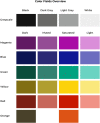Pupil responses to colorfulness are selectively reduced in healthy older adults
- PMID: 38092848
- PMCID: PMC10719259
- DOI: 10.1038/s41598-023-48513-7
Pupil responses to colorfulness are selectively reduced in healthy older adults
Abstract
The alignment between visual pathway signaling and pupil dynamics offers a promising non-invasive method to further illuminate the mechanisms of human color perception. However, only limited research has been done in this area and the effects of healthy aging on pupil responses to the different color components have not been studied yet. Here we aim to address this by modelling the effects of color lightness and chroma (colorfulness) on pupil responses in young and older adults, in a closely controlled passive viewing experiment with 26 broad-spectrum digital color fields. We show that pupil responses to color lightness and chroma are independent from each other in both young and older adults. Pupil responses to color lightness levels are unaffected by healthy aging, when correcting for smaller baseline pupil sizes in older adults. Older adults exhibit weaker pupil responses to chroma increases, predominantly along the Green-Magenta axis, while relatively sparing the Blue-Yellow axis. Our findings complement behavioral studies in providing physiological evidence that colors fade with age, with implications for color-based applications and interventions both in healthy aging and later-life neurodegenerative disorders.
© 2023. The Author(s).
Conflict of interest statement
The first author JEPL is the founder of The Thinking Eye, a social enterprise which translates novel insights from research into relationships between visual art processes and the social brain into services that aim to support psychological well-being and optimal cognitive functioning. The other authors declare no competing interests.
Figures



 ).
).
 ). In older adults, relative Magenta saturation level had the strongest effect on pupil responses, while relative Green saturation appeared to have a similar effect as relative Blue saturation on pupil responses in older adults.
). In older adults, relative Magenta saturation level had the strongest effect on pupil responses, while relative Green saturation appeared to have a similar effect as relative Blue saturation on pupil responses in older adults.
References
-
- Hunt RWG. The effects of daylight and tungsten light-adaptation on color perception*,†. JOSA. 1950;40(6):362–371. doi: 10.1364/JOSA.40.000362. - DOI
MeSH terms
Grants and funding
LinkOut - more resources
Full Text Sources

